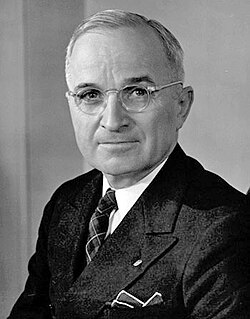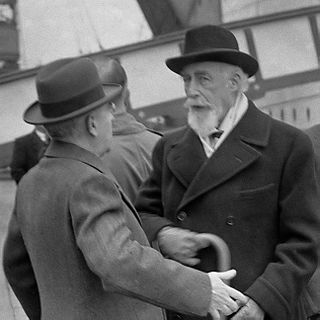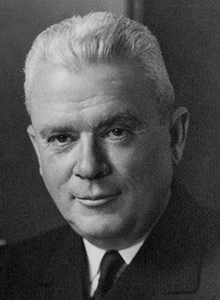
The 1944 United States presidential election was the 40th quadrennial presidential election. It was held on Tuesday, November 7, 1944. The election took place during World War II. Incumbent Democratic President Franklin D. Roosevelt defeated Republican Thomas E. Dewey to win an unprecedented fourth term. Until 1996, this would be the last time in which an incumbent Democratic president would win re-election after serving a full term in office.

The 1948 United States presidential election was the 41st quadrennial presidential election. It was held on Tuesday, November 2, 1948. In one of the greatest election upsets in American history, incumbent President Harry S. Truman, the Democratic nominee, defeated Republican Governor Thomas E. Dewey.

Henry Agard Wallace was an American politician, journalist, and farmer who served as the 11th U.S. Secretary of Agriculture, the 33rd vice president of the United States, and the 10th U.S. Secretary of Commerce. He was also the presidential nominee of the left-wing Progressive Party in the 1948 election.

The States' Rights Democratic Party was a short-lived segregationist political party in the United States, active primarily in the South. It arose due to a Southern regional split in opposition to the Democratic Party. After President Harry S. Truman, a member of the Democratic Party, ordered integration of the military in 1948 and other actions to address civil rights of African Americans, many Southern conservative white politicians who objected to this course organized themselves as a breakaway faction. The Dixiecrats were determined to protect Southern states' rights to maintain racial segregation.

James Francis Byrnes was an American judge and politician from the state of South Carolina. A member of the Democratic Party, Byrnes served in Congress, the executive branch, and on the United States Supreme Court. He was also the 104th governor of South Carolina, making him one of the very few politicians to have served in the highest levels of all three branches of the American federal government while also being active in state government.

Robert Emmet Hannegan was a St. Louis, Missouri politician who served as Commissioner of Internal Revenue from October 1943 to January 1944. He also served as chairman of the Democratic National Committee from 1944 to 1947 and United States Postmaster General from 1945 to 1947. After his political career, in 1947, Hannegan and partner Fred Saigh purchased the St. Louis Cardinals of Major League Baseball. But Hannegan, ill with heart disease, sold his share in the team to Saigh a few months before his death.

Harry S. Truman was the 33rd president of the United States, serving from 1945 to 1953, succeeding upon the death of Franklin D. Roosevelt after serving as the 34th vice president. He implemented the Marshall Plan to rebuild the economy of Western Europe, and established the Truman Doctrine and NATO.

The 1944 Democratic National Convention was held at the Chicago Stadium in Chicago, Illinois from July 19 to July 21, 1944. The convention resulted in the nomination of President Franklin D. Roosevelt for an unprecedented fourth term. Senator Harry S. Truman of Missouri was nominated for vice president. Including Roosevelt's nomination for the vice-presidency in 1920, it was the fifth time Roosevelt had been nominated on a national ticket. The keynote address was given by Governor Robert S. Kerr of Oklahoma, in which he "gave tribute to Roosevelt's war leadership and new deal policies."
Robert Hugh Ferrell was an American historian and a prolific author or editor of more than 60 books on a wide range of topics, including the U.S. presidency, World War I, and U.S. foreign policy and diplomacy. One of the country's leading historians, Ferrell was widely considered the preeminent authority on the administration of Harry S. Truman, and also wrote books about half a dozen other 20th-century presidents. He was thought by many in the field to be the "dean of American diplomatic historians," a title he disavowed.
This Bibliography of Harry S. Truman is a selective list of scholarly works about Harry S. Truman, the thirty-third President of the United States (1945–1953).

The presidency of Harry S. Truman began on April 12, 1945, when Harry S. Truman became President of the United States upon the death of Franklin D. Roosevelt, and ended on January 20, 1953. He had been Vice President of the United States for only 82 days when he succeeded to the presidency. A Democrat from Missouri, he ran for and won a full four–year term in the 1948 election. Although exempted from the newly-ratified Twenty-second Amendment, Truman did not run again in the 1952 election and was succeeded in office by Republican Dwight D. Eisenhower.

The Democratic Party's 1944 nomination for Vice President of the United States was determined at the 1944 Democratic National Convention, on July 21, 1944. U.S. Senator Harry S. Truman from Missouri was nominated to be President Franklin D. Roosevelt's running-mate in his bid to be re-elected for a fourth term.

Herman B. Baruch was an American physician and diplomat who served as United States Ambassador to the Netherlands and Portugal.

Alexander F. Whitney was an American railway worker who became president of the Brotherhood of Railroad Trainmen (BRT). He was an influential labor leader during the Great Depression and World War II, and in the years immediately following the war. He was the principal leader of a two-day railroad strike in May 1946 that paralyzed the nation.

James Kimble Vardaman Jr. (1894–1972) was an American lawyer from Mississippi, a US Navy captain during World War II, and political aide to President Harry S. Truman. He had worked as counsel for banks in Missouri before the war, and was appointed as a Governor of the Federal Reserve System, serving from 1946 to 1958.

Harry S. Truman: A Life is a 1994 biography of Harry S. Truman, president of the United States from 1945 to 1953, by historian Robert Hugh Ferrell. Although it was overshadowed by the popular success of David McCullough's Pulitzer-winning biography Truman, Ferrell's book was widely praised by scholars in his field.

Dear Bess: The Letters from Harry to Bess Truman, 1910-1959 is a 1983 book edited by historian Robert Hugh Ferrell collecting more than 500 letters from U.S. president Harry S. Truman to his wife Bess, ranging from the couple's early courtship to his post-presidency retirement. Well-regarded by other historians, the book also achieved popular success, becoming a New York Times bestseller.

Off the Record: The Private Papers of Harry S. Truman is a 1980 book edited by historian Robert Hugh Ferrell which collects writings and correspondence by Truman, the 33rd U.S. president, between 1945 and 1971. Historian Donald R. McCoy, writing in Presidential Studies Quarterly, called it a work of "great scholarly value … which is easily one of the most important and interesting books dealing with the recent Presidency published during the past decade."

The Dying President: Franklin D. Roosevelt, 1944–1945 is a 1998 book by historian Robert Hugh Ferrell about the cardiovascular illness which Roosevelt suffered during the last year of his life and presidency. Ferrell examines the lengths to which the president and his medical advisers went to keep the public in the dark about the illness, as well as the political and diplomatic problems that arose both from the illness and the secrecy. He argues that Roosevelt was too sick to have remained in office, and that his inability to work led to critical foreign-policy mistakes in the closing year of World War II and a failure to properly prepare Harry S. Truman to take over as president after Roosevelt's death.

Ill-Advised: Presidential Health and Public Trust is a 1992 book by historian Robert Hugh Ferrell examining politically motivated cover-ups of serious medical issues afflicting U.S. presidents while they were in office. Although Dwight Eisenhower is the main focus of the book, it covers the presidency for a century, from Grover Cleveland's mouth cancer in 1893 to the health of George H.W. Bush, then-current president when the book was first published. All of these instances, Ferrell argues, raised serious questions about the fitness of each president to hold office, as well as whether the presidents and their physicians violated the public trust in keeping the incidents secret.


















